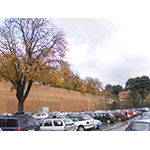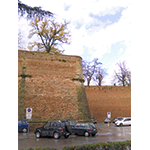Fortezza Medicea di Siena [Medici Fortress of Siena]
After the city had fallen first to the Spanish and then to the Florentines, in 1560 Cosimo I de’ Medici ordered the construction of a fortress having the principal task of serving as a garrison against possible attempts by the Sienese to regain their independence. The construction rises on the site of the old Spanish fortress, which the Sienese had razed to the ground in 1552. Symbol of the power acquired by the Medici over the city of Siena, it is no surprise that the fortress was carefully maintained for a couple of centuries, while the walls were practically left in a state of abandon.
Soon after the mid 16th century, military engineer Baldassarre Lanci from Urbino entered the service of Cosimo I de’ Medici and modified the original L shape of the fortress into today’s square structure. This was also the period in which Lanci built the topographic instruments for the Grand Duke’s collection, which are today conserved in the Institute and Museum of the History of Science in Florence.
In the late 18th century, the Fortress was demilitarised and transformed into a public garden adjoining Lizza, a vast area designed by Antonio Matteucci in collaboration with famous German gardener Leopoldo Prucher.
A venue for temporary exhibitions, the Fortress today hosts the cultural association Siena Jazz that organises courses for musicians and music workshops, and the Enoteca Italiana that holds a wine show with sampling of the finest Italian wines.
****************************
Texts by Antonella Gozzoli
English translation by Victor Beard
Last update 07/feb/2008





